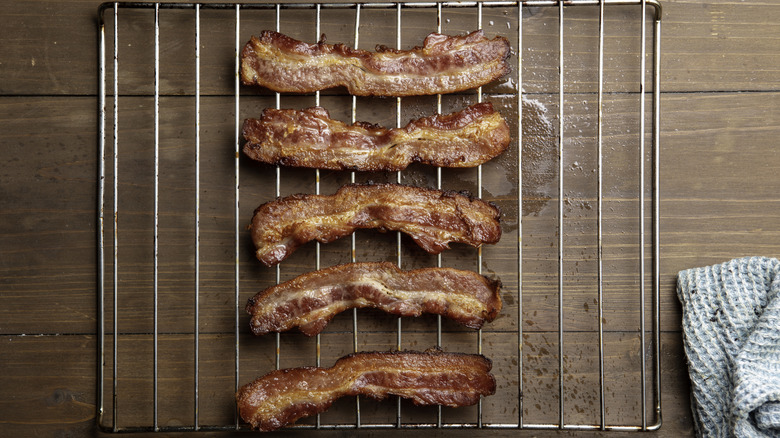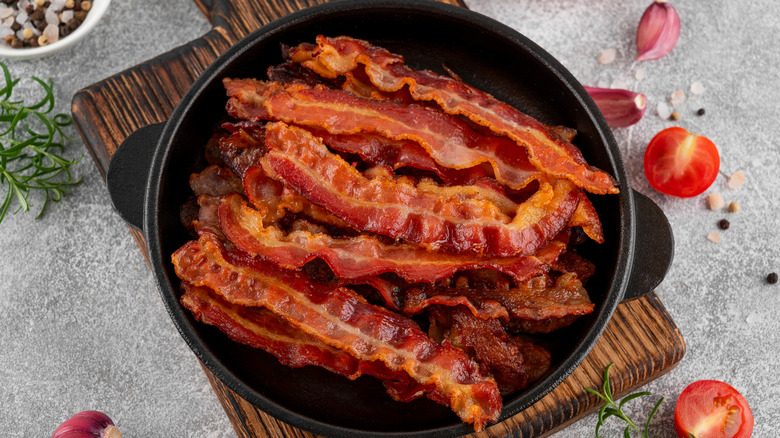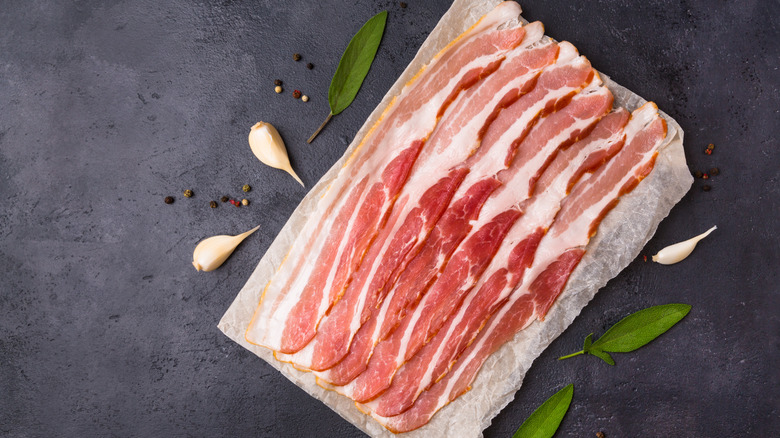The Tell-Tale Signs Your Bacon Is Undercooked
Bacon is so much more than a breakfast meat and can be used beyond being a salty, squiggly little smile to curve below two sunny side up eggs. It transcends one purpose, finding use well beyond the breakfast plate. It is the bold "B" on a BLT sandwich (or BLT pasta salad), a salty, rich sprinkling on a maple glazed donut, and the cinching tie that brings together the iconic jalapeño popper. Beyond its versatility, bacon holds another appeal: It's easy to cook. You can fry it, microwave it, or even cook it in the oven if you so please. There is, alas, one hitch. It can be difficult to tell when bacon is fully cooked.
Now, this may not be an issue for those who like their bacon burnt black, but for those who enjoy a more floppy, pinkish bacon, determining when your bacon is done can be quite difficult. In terms of official guidance, bacon is generally considered safe to eat once it has reached an internal temperature of 148 degrees Fahrenheit. However, bacon is usually pretty thin, so properly gauging your bacon's doneness with a thermometer can be rather difficult.
Luckily, there are a few ways to tell that your bacon is fully cooked, sans thermometer. You'll just have to look for a few visual cues, including change in color, firmness, and size. Generally, uncooked bacon will be much softer and wetter than cooked bacon. It will also be pale in color.
Determining your bacon's doneness
You now have a general idea of what to look out for when making sure your bacon is fully cooked, but there are a few key factors you'll want to keep in mind next time you fry up a few cuts. Perhaps the most important clue to sussing out undercooked bacon is its texture. Cooked bacon, even if it isn't burnt stiff, will be firm and should for the most part hold its shape. It should also, after blotting off excess oil, be dry to the touch. If your bacon feels wet, that's a clear sign that it should go back in the pan.
Additionally, the fat portion of your bacon should be relatively thin and translucent, as fat is rendered out during the cooking process. If your fat is still white, opaque, and greasy, it isn't fully cooked. The meat portion of your bacon should also become darker as it cooks, turning from a pale pink (or sometimes grayish color) to a deep reddish brown. Your bacon needn't be fully dark brown or stiff as a board, but it should have darkened in color and have some structural integrity. You should also notice a fair amount of shrinkage when cooking, and the edges will begin to curl up as it shrinks. In fact, your bacon can shrink by up to 40% when fully cooked. So, if your bacon is still thick, slimy, opaque, and pale, these are all signs that your meat may be less than done.
Why cooking your bacon is so important
Bacon may seem to be, like other cured meats, to be safe to eat as-is, regardless of doneness. However, this is not the case. For starters, not all bacon is cured, and raw bacon is still, well, raw, and it's therefore unsafe to eat. After all, bacon is a cut of pork, and though cooked pork is safe to consume, raw pork simply isn't. Consuming bacon can lead to bacterial and parasitic infections, including tapeworms and trichinosis. These can make you seriously ill. In fact, in 2024, it was reported that an American man became infected with tapeworms in his brain after consuming undercooked bacon. Of course, severe infections like this are rare, but it is best to stick to the safe (and crunchy) side when making bacon.
In addition to fully cooking your bacon, you should also keep a few other safety pointers in mind. If you're starting with frozen bacon, for example, you should always thaw it in the fridge and never at room temperature. Letting your bacon sit at room temp will allow for bacterial growth that can make you sick. Additionally, you shouldn't ever store half cooked bacon in your fridge, as this will also allow for increased bacterial growth. If you can't fully cook your bacon in one go around, it's best to toss it out. However, fully cooked bacon can be kept in the fridge for up to five days. But besides the universal rule of keeping uncooked bacon refrigerated, the most important guidance in bacon storage is to pay close attention to its best by date, making sure to toss anything that is even suspected of being past its prime.


